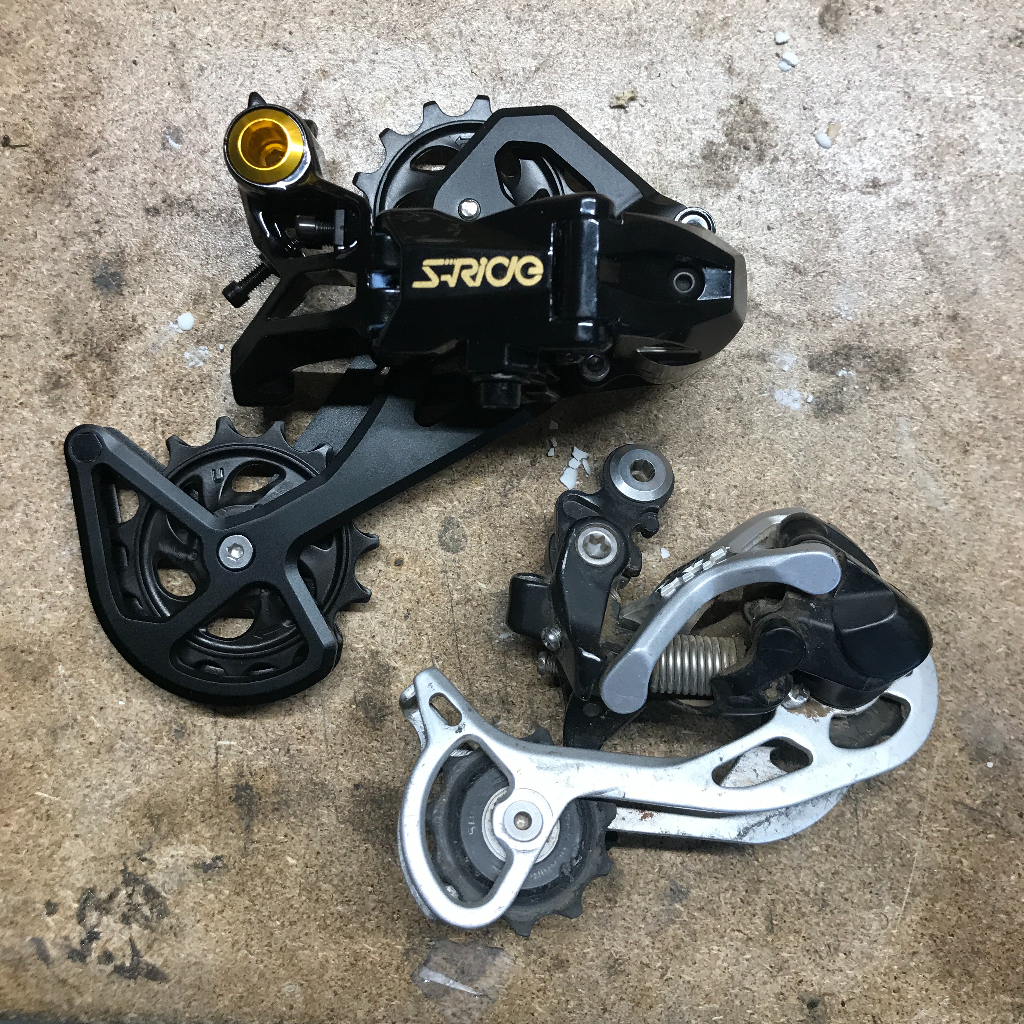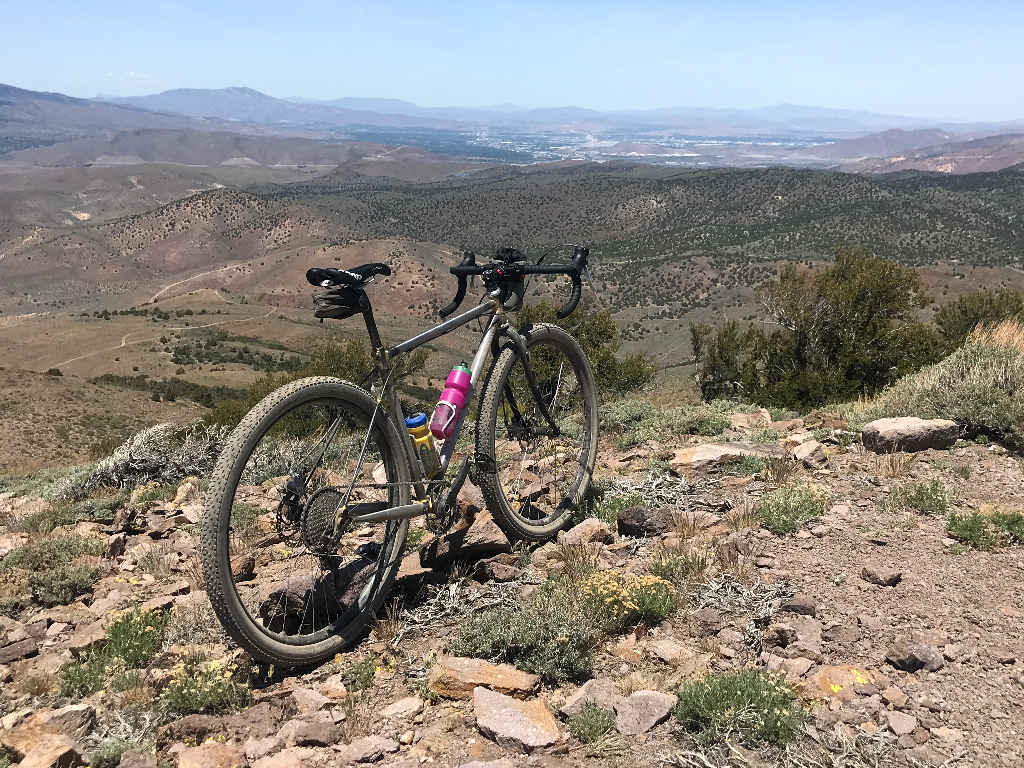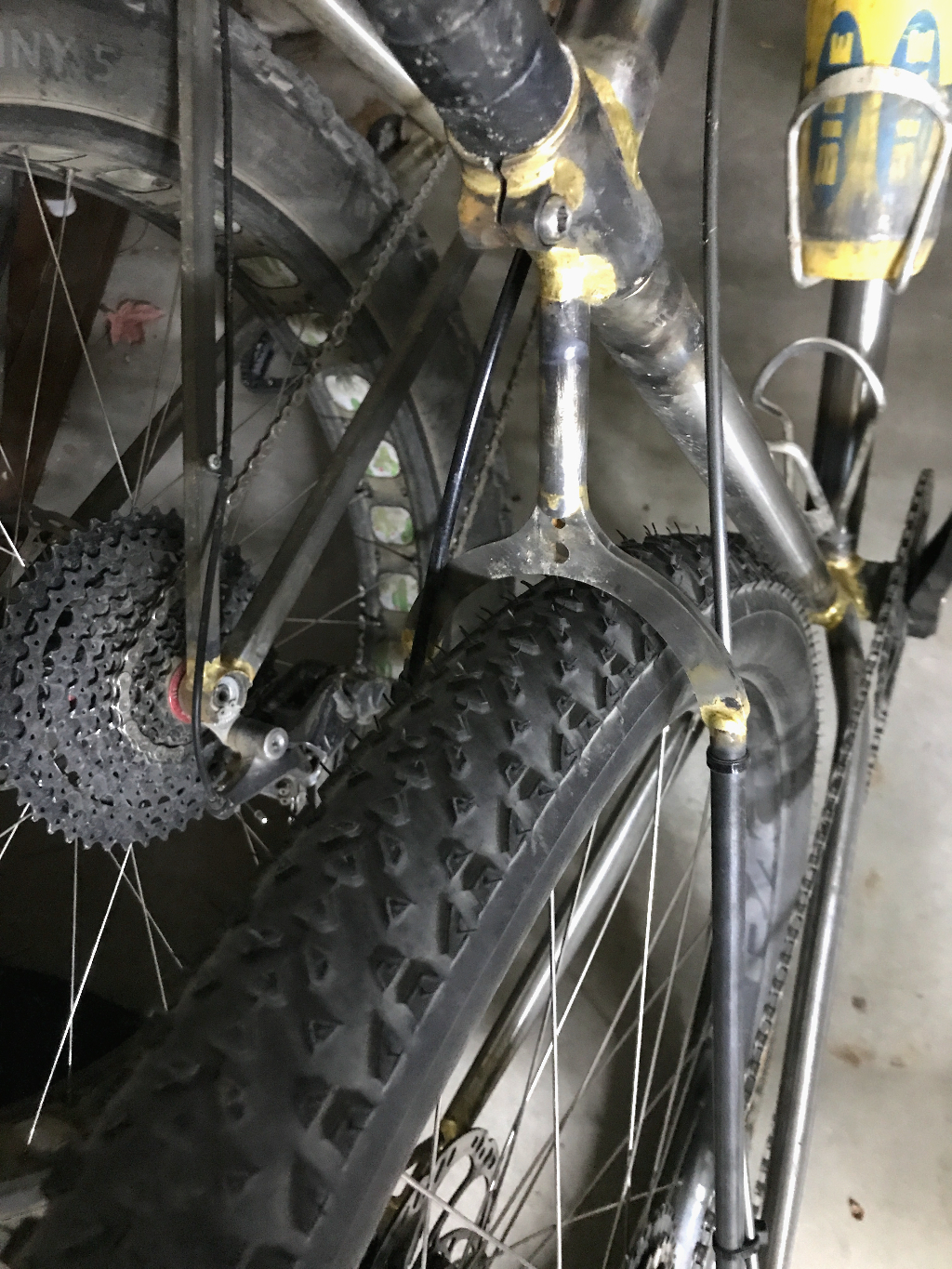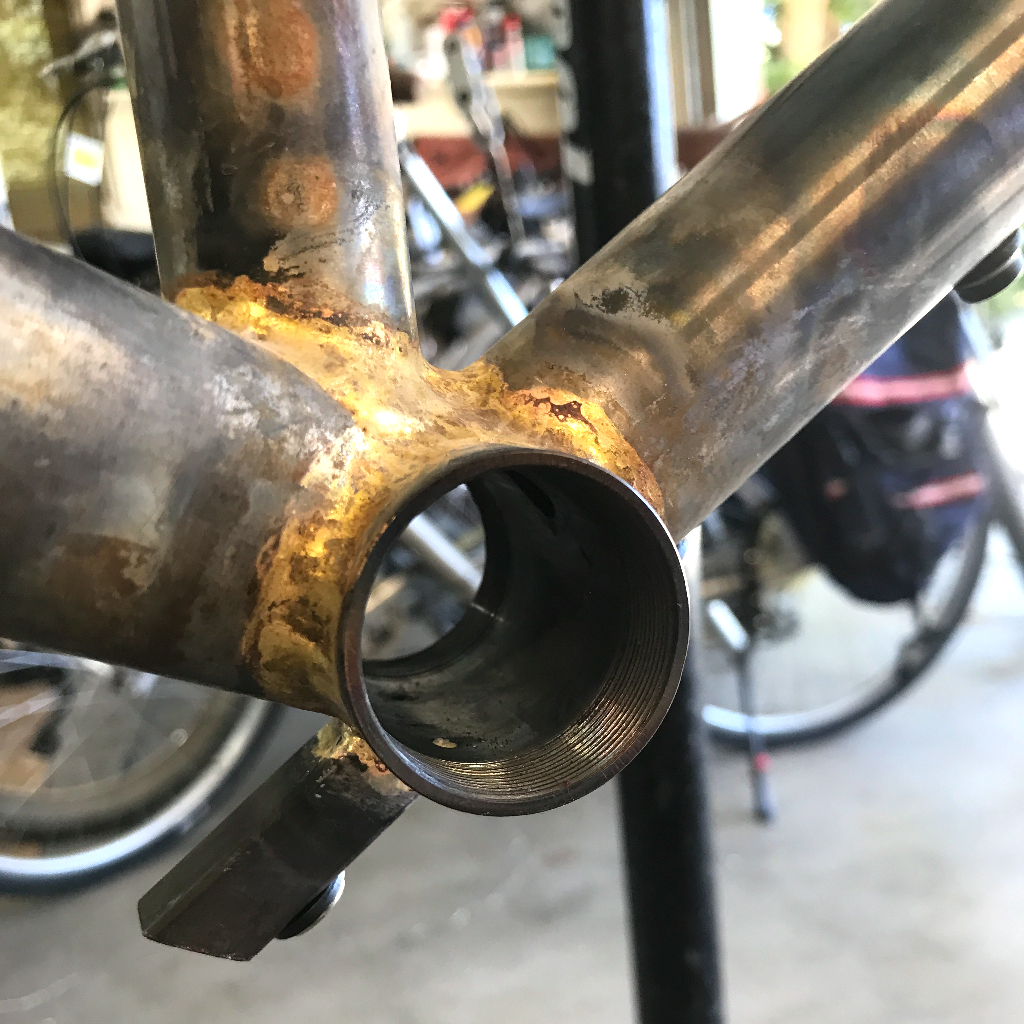Bike Check: SC-3
Number 3 in the "Short Crank" series is a formal replacement for SC-1. While it rode fine it was meant to be a test mule and there were a few things I wanted to update too. This year I also was planning to ride the 200k "Ruby Roubaix" long loop so I wanted a new whip to take on the challenge.

First design change was around wheels. Well actually tires. SC-1 had enough clearance to run 29x2 Thunder Burts which are crazy fast tires, but the ones I have are the Liteskin casing and they're too easy to cut around here. I had been keeping an eye on Dylan Johnson's experiments with using formerly uncool 29" XC racing tires for gravel and he was finding success with the Continental Race Kings. From other internet chatter they were supposed be much tougher too, and they come in a 2.2" size so it sounded right up my alley.
For wheels I could steal my trail bike wheels of Race Face Arc 29s laced to a Shimano MT900-B (non-series XTR) Boost front hub and a 102 POE Funn rear hub in Superboost. The short-lived #18 gravgrav bike used a standard 142 rear hub offset 6mm to get an extra smooth chainline, so recycling the Superboost hub would do the same here. Having the wide chain line would also help fit the big tires and my legs work better with a wider Q factor anyway. A 29mm inner width rim seemed like a little overkill but these were ready to go and I'm not one to micromanage rim widths over a couple of millimeters.
Another thing I wanted was a smoother riding fork. In other words: steel. Sure, a carbon fork is lighter, but I'd rather have something smooth to stay fresher for longer rides. I'd also need something that could clear the 2.2 Race Kings with room to spare. Kona sells replacement forks from the Sutra ULTD that are pretty perfect for this application - 430mm axle to crown, straight steerer to save weight and add some compliance, and an affordable price tag to boot. Just one bummer - they're flat mount which I wasn't too excited about. Being OEM touring forks, they're probably a little on the heavy side. Those two features weren't deal killers, but since the forks are also 12 x 100 through axle, I would have had to relace my existing front wheel or maybe come up with another wheel option.
Then I discovered the Ritchey WCS Steel Adventure fork. Built for the Ascent, it's also 430mm axle to crown and uses a straight steerer. This one uses a sensible post mount and is Boost, so it was a winner on all fronts. The price tag is a little tougher to swallow for a steel fork, but thanks to Tom's experience building light steel bikes, this fork is significantly lighter than other OEM options. I was especially impressed with the steerer tube that had some tricky internal butting and machining to make it light. The extra cost is not a "name tax", this is premium steel.
Cranks were carried across from SC-1, the Goldix 155s with a generic 38t narrow-wide. For shifting I had tried a couple different mechanic brake options over the last year. LTwoo GR-9s worked good enough for shifting and were a comfortable shape but the brake reach seemed too long even for my big hands. Microshift SB-M110s had better reach but were cramped otherwise, and having the two levers stacked on top of each other meant I'd sometimes hit both which sort of cancelled out the shift. The presence of a shift lever behind the brake lever was getting in the way of technical braking on the hoods so in the end I went back to my old Gevenalles with a MTB pull shift lever. I'd rather have better braking when I really need it than the ability to shift from the drops.
At the other end of the shift cable I gave in to my weird derailleur addiction when Soma Cycles had 60% off Sride derailleurs. I was really happy with their RD-520c ultra wide range "Gravel" rear derailleur, so I was curious about one of their fancier MTB derailleurs. I'd have a hard time spending $110 on an unknown rear derailleur, but with the discount the RD-M610 was about the same price as my usual choice of the Deore 5100. Turns out it was worth it not only for the novelty but also for the performance. Out of the box, the RD-M510 is HUGE. It must be really easy to smash into rocks as a mountain bike derailleur. However, it's also light, and on top of that its size makes it extremely stiff. It shifts SUPER fast making it a great choice for a 1X gravel bike if you're running something that can shift a MTB cable pull. For brakes, I stuck with the tried and true Hayes CX. I ended up putting 180mm rotors front and rear after smoking a 160mm rotor (the first time I've done this on any bike, which should tell you this bike is capable of going faster than it should).

For the cockpit, 44cm Zipp Service Course 70 Ergo handlebars have flat tops with a great backsweep. I had also tried the same bars in the XPLR version but I don't really like bar flare. For extra smoothness, I ran a 25.4 Cannondale SAVE seatpost with a shim and of course an SMP saddle.

For the frame I dug into my tubing pile. I had a set of oversized Nova "Mad Max" 29" chainstays that I could fit given the longish stays and wide chainline. Since they're tapered, I thought they'd look good with some modular dropouts that don't fit the big rectangular stays I use on most of my builds so it was a good opportunity to put them to use though in the end I don't think I like the design that much. Their extra width made it tricky to find a Superboost through axle long enough and they didn't cooperate with my ISO disc mounts as well as my prefered round Paragon dropouts. For main tubes a boring 9/6 seat tube was good enough. I was hoping to build it single oversize 31.8/28.6 main tubes, but I couldn't find the right lengths in my stash. I did have some nice 34.9/31.8 choices, so I went with those instead. I think that choice complemented the giant chainstays, longer fork, and bigger wheels. The flex feels very "right" - it's smooth but doesn't get overwhelmed and wiggly when you push it. Straight head tube since the fork has a straight steerer and I see no reason to replace such a nice riding fork with something stiffer to save weight. For the chainstays, I laser cut a yoke plate for a monostay top to be able to finish the stays faster. Everyone thinks it's for compliance but it's just for lazy construction. I made some upgrades to my jig to help keep everything straighter but for some reason this frame kept trying to wiggle away from me. I got it all where I wanted in the end but it was a fight!

I did make one frame modification after I built it. I felt like where I put the bottle mounts under the down tube was a little high. It was about the same position as on my flat bar bikes, but here it just felt cramped and I thought it might be nice to try to get the bottle's center of gravity lower on the frame. I ended up adding a "pitot tube" extension that hangs the bottle below the bottom bracket. It's small detail I haven't seen before and I'm pretty happy with how it came out.


Geometry was pretty close to SC-1. Top tube a little shorter since I'm sitting further back and thanks to long arms I have plenty of front center even with a 90mm stem. Head angle a little steeper at 71 degrees to cut down some of the out of the saddle flop and to make up for the bigger wheel slowing everything else down. The bottom bracket height was placed at 283mm and the chainstay length is technically shorter since the forwards bottom bracket offset was a clean slate design and not restricted by where I was able to put the second shell on the down tube of SC-1. Since that bike had a steeper seat tube angle some of the differences cancelled out. Like SC-2, I also offset the seat tube back which makes it look like a normal 73 degrees but it's actually 71 effective. As I have explained elsewhere, since the bike has 155 cranks the pedal ends up about in the same place in space as if I had a 73 seat angle and 175 cranks. With the aadjustment the chainstays end up at 465mm.
It took a little experimentation with stem spacers to get the right spot where I could sit in the drops as long as I wanted. Saddle height got a couple millimeters of tuning but I found that there's a clear limit to where I start losingseated power. At this height I can't seem to spin as fast as I used to, but I just shift up a gear and focus less on pure spin and more on smooth delivery across and down the power segment of the pedal stroke. I'm beginning to think that I have been relying on RPMs to get power since my position and technique was hampered in torque delivery.
The tires are pretty much flawless. Running the front at 18 PSI I was able to bottom it out plowing into rocks and got a faint cut in the tire which sealed right up. In the rear there's at least one knob that's almost ripped off. So they have gotten more than a hard workout getting underbiked in desert rocks. They float well and smooth out the wild horse trails. Combined with the fork and seatpost I can power through sections I previously was getting shaken to pieces. On the road they feel no slower than any other gravel tires I've run and having gotten used to the size visually they look "normal" now and older 40mm gravel tires look like skinny road tires. They don't have big side knobs so they can get a little sketchy trying to sidehill on ruts but that's not really something I seek out on this bike. I have nothing interesting to report about using them on 29mm rims, they seemed normal in all regards. I do think the Liteskin Thunder Burts are a little faster, but they're a non-option for me.
Getting ready for the Ruby Roubaix I didn't get in any big mileage on the bike, sticking more to steeper underbiking routes. The bike did well in those situations, but also when I was just doing flat efforts in the wind I was really happy that I could also stay low and aero without feeling like it took additional effort to hold that position. One thing I've become more aware of getting close to a year on 155s is that my torso is much more open to breathing deeply. I'm able to open my diaphragm with less restriction from a curved lumbar spine as well as core tension trying to brace in an aero position. Up until this bike I've been trying to force an aero position by stretching out, with sort of a "no pain, no gain" mentality that aero positioning was something you had to train for. But something about it always felt wrong, so in going with my intuition this has been a big change. From speedskating I had an ingrained sense of balance and getting small that was counter to traditional bike focus on leg extension and getting low by increasing your reach. Thanks to Colby Pearce for breaking down fit traditions and emphasizing listening to your intuition.
Race day eventually came around, though let's be honest, it's a fondo and I wasn't racing anyone. Temps were forecast in the 90s but there were aid stations every 15 miles. I cruised out at the back of the pack to the first aid station which I initially thought I would skip. But nature called and I needed a pitstop in the porta-potty. I had also planned to drink a full bottle in between rest stops and do my first refresh at the second stop. But since I was there and stopped and had an empty bottle I refilled it anyway. This turned out to be the better plan, because every other aid station turned out to just be a water stop, and this put my two-bottle refresh schedule to align with the aid stations with food.
A side note on fueling: I ran a mix of 90g table sugar and 1/2 tsp sodium citrate per large water bottle, flavored with one packet of TrueLime powdered lime and grapefruit. I had been experimenting with different sugar concentrations and was able to go higher than 90g without any digestive system problems, but I cut it back to what seemed like a safe amount. Back in the Odin's Revenge days I ran a 2:1 maltodextrin mix but was turned off by the texture of the malto. Pure sucrose works much better for me, though I enjoy the sweetness and the citrus powders temper the sweetness with some acidity.
Since most of the other riders skipped the first aid station I got back on the course further back in field. There was a flat fast section where I tucked in and caught a few people, then we hit a ranch road section that turned out to be mostly sand. In my element both with big tires and over 30 years of experience riding drops in sand I blew past piles of riders struggling to go in a straight line. We eventually got back to pavement and some of the nearby riders took this as their cue to hit the gas and they pulled away from me, but after a few miles rolling miles we hit the bottom of Harrison Pass and they all faded back as the road got steeper. Here I picked off a couple riders as we climbed to the next aid station at the top of the pass. I left the aid station by myself so had no one to compare descending against but I'm going to assume I would have made gains like I did in the sandy section.
With Harrison Pass behind us, we were now facing about 40 flat miles going north through the Ruby Valley. I was alone so I tucked up again and picked a good pace I thought I could hold. After 5 or 10 miles a small group was visible behind me so I decided to throttle back just a little to let them catch up. The gravel here is packed smooth with mag chloride and I was honestly bored, so working in a group would at least give me some more mental stimulation riding this long flat stretch. They eventually bridged up and I jumped in the paceline. It was soon evident that it wasn't a paceline in the sense there was a pace. Instead every guy decided the strategy was to pin it as soon as they got to the front with the idea that this would result in a higher average pace. I guess since road cycling is dead people aren't learning how to make a paceline work. So the group was constantly breaking up. Without any consistency at some point things got disorganized enough that I decided to get as aero as I could and stick to one pace and the group faded back.
The miles went by. I stayed low and felt pretty good at the pace I was doing. I got the last aid station in the Ruby Valley and had an efficient reload and refuel and left before some other riders who arrived before me. It seemed like the pacing strategy was working out for me. But as I started climbing out of the valley and over Secret Pass I was really starting to notice the heat. But soon we would have the descent down to the pass to recover and cool off.
Unfortunately that didn't quite happen. A hot headwind was blowing UP the canyon, stymying my hopes to coast and cool off. I could really feel the heat the bouncing off the rock walls of the canyon, and getting towards the bottom I started getting the chills and dizziness of impending heat stroke. I limped in to the last aid station and was strongly considering calling it in and getting a ride before the heat did more damage. I sat in the shade for a half hour, ate some food, had a coke, and contemplated what to do.
There was about 25 miles left of rolling hills. I had ridden these roads many time so I knew how to pace them. I also knew there were a bunch of creeks and irrigation ditches along this side of the valley. I decided to limp back, stopping at every creek to cool off completely. This strategy got me back safely. In the end it was a bummer to have the heat derail everything but I was at least happy with my effort given temperatures weren't cooperating and I'm glad I din't foolishly try to power through it just to end up in the hospital. The bike worked perfectly except for losing my third bottle, but that wasn't a problem since it was intended to be a backup. Riding this bike was a joy and it felt like it was complementing all my efforts. And I was happy that I could check off the big Ruby loop, though I don't think I need to race this distance again in the heat. Maybe next time I'll tour it over two days in the fall. While the bike seems to unlock speed I didn't know I had, it's so comfortable it should just as fun to pedal it slow and enjoy the scenery.